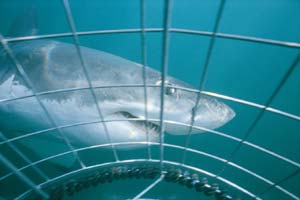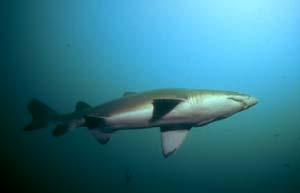
|
|
|
|
|
|
Shark Info (12-15-2001) |
Author |
|
Intro: |
Shark Info |
|
Main article: |
Volker Berbig |
|
Article 1: |
Dr. E. K. Ritter |
|
Article 2: |
Andrew C. Cobb |
|
Article 3: |
Shark Info |
|
Fact Sheet: |
Dr. E. K. Ritter |
|
Controlled shark diving in South AfricaBy Andy Cobb
The change of government in South Africa also resulted in various amendments to the country's
constitution.
Aliwal Shoal – Umkomaas
When it comes to establishing guidelines, the Aliwal Shoal diving grounds in Umkomaas off the
coast of Kwa Zulu in Natal represents a problematic region (also see Shark
Info 1/2000).
Establishing a "Code of Conduct"These increasing conflicts led to an open discussion between the different interest groups and MCM's management on August 18, 2001. All interest groups were allowed to speak their mind and either support or oppose shark feeding in Aliwal Shoal waters. The MCM decided that these activities had to be regulated and in a first phase they worked out different regulations which then had to be tested. One initial requirement called for all involved diving tour businesses to log their excursions so as to determine how many divers actually visited the Aliwal Shoal region. In addition, a fee was introduced which differentiated between commercial suppliers and leisure time sportsmen. Since - from a diving point of view - this region was considered a more demanding area, any form of diving instructions was prohibited in order to prevent the sand tiger sharks from being even more strongly affected by unauthorized divers. One major aspect was the restriction placed on luring tiger sharks with bait closer than a radius of one kilometer around the actual Aliwal Shoal. Lessons in shark biology for representatives of scuba diving businessesAn additional step to help eliminate disturbances to sand tiger shark populations is to educate representatives of diving companies in biology. Those who want to continue making diving excursions to sharks would have to attend courses in shark biology, on the one hand to enable them to provide diving tourists with the necessary information, and on the other to be better informed themselves. Those who conduct diving excursions must be capable of recognizing possible changes in a shark's behavior and responding accordingly. Such training is based on the Tourism Hospitality Sports Education Training Act (THETA), the umbrella organization for the education of tour leaders in South Africa. The first meeting between THETA and the already completely trained shark divers, took place at the end of September 2001 in Cape Town and was sanctioned by local diving associations. The meeting's objective was to establish training guidelines to be fulfilled by divers in order for them to receive authorization as official THETA Shark Tour Guides. ResultThe new government of South Africa succeeded in giving sharks the official status of marine "tourism species", a status already enjoyed by whales and seals which makes it possible to legally control tourism activities with these animals. From now on, disturbing these animals in their habitat must be reduced to a minimum and quick action is guaranteed should further protective measures become necessary. Under the new law, Aliwal Shoal becomes an officially recognized nature reserve as of 2002. * Andrew C. R. Cobb iis a prominent shark protector in South Africa. May be published only by indicating the source: Shark Info / Andy Cobb |
|
|
|
|
|
|||||

